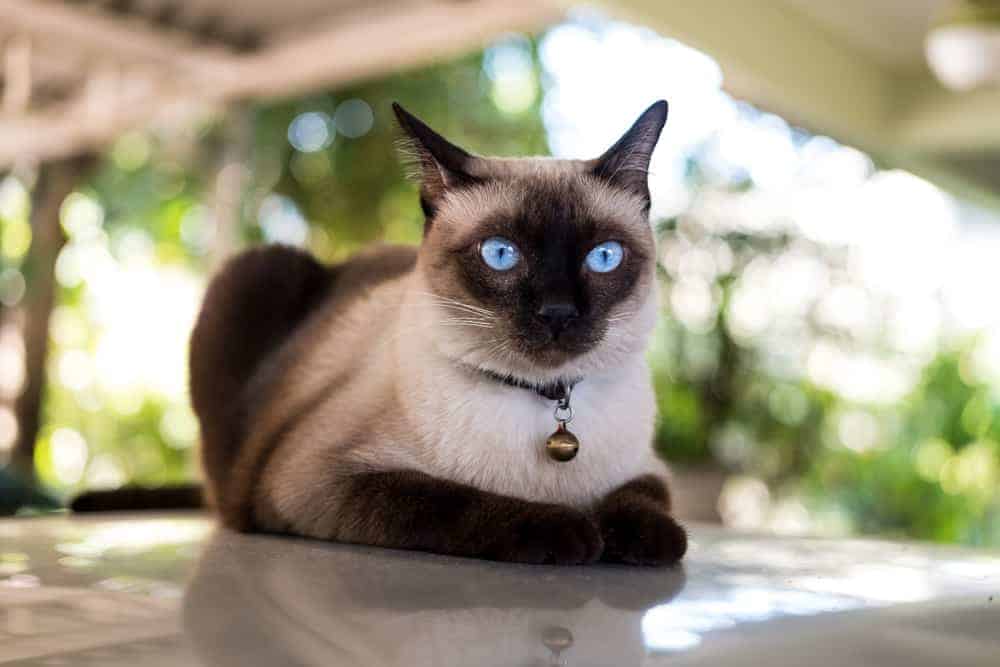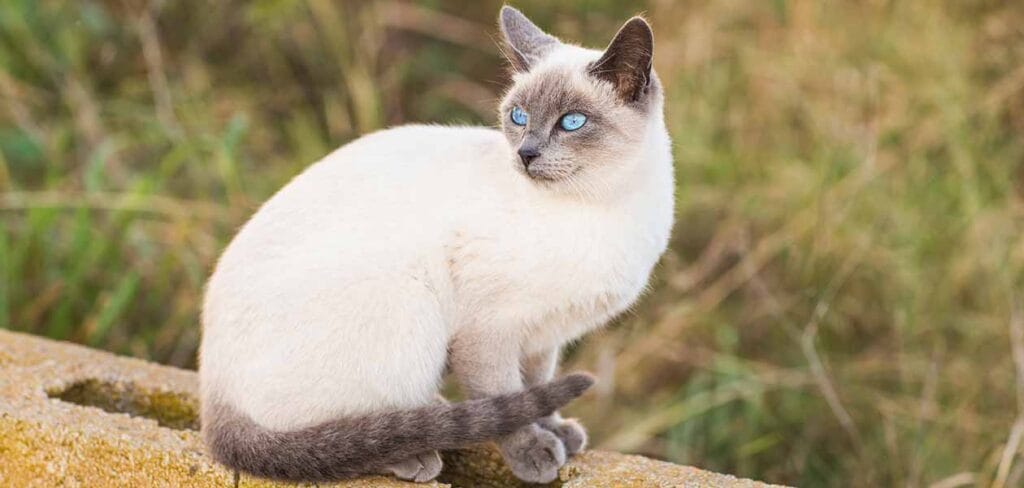Characteristics, History, Care Tips and Helpful Information for Pet Owners
The medium-sized, sleek, and polished Siamese cat has long, tapering lines. It has slender muscles. The most distinguishing characteristic of the Siamese cat is its “points,” which are richer color patterns on the ears, face (mask), tail, legs, and feet. Those looking for a pedigreed pet prefer siamese cats, commonly known as “meezers.” One of the earliest pedigree cat breeds, the Siamese cat was initially acknowledged by the Cat Fancier’s Association in 1906.

Breed Overview
- WEIGHT: 6 to 14 pounds
- LENGTH: Up to 14 inches
- COAT: Short
- COAT COLOR: Seal, chocolate, blue, and lilac
- EYE COLOR: Blue
- LIFE EXPECTANCY: 8 to 12 years
Characteristics of the Siamese Cat
| Affection Level | High |
| Friendliness | High |
| Kid-Friendly | High |
| Pet-Friendly | High |
| Exercise Needs | High |
| Playfulness | High |
| Energy Level | High |
| Intelligence | High |
| Tendency to Vocalize | High |
| Amount of Shedding | Low |

Past of the Siamese Cat
Siamese cats are produced by Thai cat breeders. The King of Siam gave two pairs of Siamese cats to the English consul-general in Bangkok in 1880; when he brought them back to England, they became the talk of the town. Their popularity soared as more people longed to get one of these magnificent “Oriental” cats. The first Siamese to receive the title of champion was Wankee in 1898, and the breed quickly developed after that.
It is unclear whether judges in official Siamese show rings followed Siamese breeders or the other way around, but for whatever reason, the Siamese cat gradually took on a leaner appearance and a more wedge-shaped head. The modern Siamese cat breed is more like the ancient Egyptian cats.
A group of Siamese breeders who were concerned about potential health problems and horrified by the radical changes in the modern breed’s appearance founded the Traditional and Classic Cat International register in 1987. One of the goals of the club was to “bring back and maintain the ‘Old Style’ look of each breed.”

The adjectives “traditional” and “classic” are frequently misused while discussing Siamese cats. The traditional Siamese cat association’s founder, Sheelagh Le Cocq, claims that the classic Siamese is a cross between the traditional and modern varieties, lacking the excesses of either. She names the classical era as lasting from 1945 to 1970.
Si and Am, the Siamese cats shown in the song “We Are Siamese If You Please” from the animated Disney film “Lady and the Tramp,” are well-known Siamese cat stereotypes. A Siamese was the star of “That Darn Cat!”
Maintaining Siamese cats
The Siamese cat’s short coat just has to be maintained on a regular basis. By brushing your cat once a week, you can lower their risk of acquiring hairballs. Only the cooler parts of the skin produce the black pigment melatonin, which results in the skin’s distinctive point pattern. The skin gets cooled during breathing, which is why the legs, ears, and face are darker in hue.
Your cat’s claws might require frequent trimming every 10 to 14 days. To prevent damage to the fabric and wood of your furniture, provide a scratching post. Pay attention to your cat’s oral health, start brushing it regularly when it’s young, and schedule frequent veterinary dental cleanings.
The personality of Siamese cats is well renowned for being both trainable and lively, playful, and interested. They ought to have a cat tree or some other kind of climbing structure because they like to climb. They also like to chase puzzle and teaser toys. If you leave this cat alone while you are gone, you might return home to discover it amusing itself by getting into mischief.
Siamese are quite outgoing with people. Like dogs, they build close ties with people and will follow you inside the house in an effort to get your attention. Your cat will be in your lap as soon as you take a seat. They need constant companionship, therefore if you leave them alone for an extended period of time, they will become depressed. They therefore function best in a home where you spend most of the day.
The Siamese cat breed is among the noisiest cat breeds. When you aren’t paying attention, they will correct you and speak to you as if you were fluent in their language as they engage in frequent conversation with you.
Siamese cats get along well with both families with small children and dog breeds that are pet-friendly. Young children should be taught how to treat cats in order to avoid the cat becoming defensive.
Cats who are kept exclusively indoors live longer. This prevents illnesses from the environment and other animals as well as injuries from accidents and fights. A secure yard gate may keep predators away, but a Siamese cat will probably scale any fence to escape. Spaying or neutering is beneficial for any pet that is not being used for breeding.

Common Health Problems
The most typical medical condition affecting Siamese cats is an eye condition. Once upon a time, cross-eyed Siamese were rather common; the gene that gave them colored points also resulted in incorrect brain wiring for vision. Siamese cats still have less acute vision than other cats, which puts them at higher risk of being hit by cars while out and about in the dark, even if the tendency for crossed eyes has largely been bred away.
Serious health problems like the ones listed below are also prevalent in this breed:
- Respiratory system disease: Siamese cats with wedge-shaped heads are more prone to respiratory conditions like asthma and bronchial disease.
- Amyloidosis, an abnormal protein buildup in the body’s organs that causes liver problems, is a condition that affects the liver.
- The buildup of the same abnormal protein in the kidneys results in renal amyloidosis, which impairs normal kidney function.
- Congenital heart conditions like hypertrophic cardiomyopathy, a common cat heart condition, can lead to cardiac failure.
All of the routine immunizations, medical exams, and preventative care should be given to your domestic cat.
Food intake and diet
Dry cat food can help keep a cat’s teeth and gums healthy, whilst wet food provides fluids to cats who may not drink enough water. By providing clean, fresh water, you can stop your cat from shunning it. Some cats may overeat if they have full access to food, but many do so naturally. If your cat seems to be putting on weight, you might wish to give him two meals a day and take away any leftovers.
Your cat could need a changed diet as it ages. About your cat’s dietary needs, talk to your veterinarian. Preventing obesity is the best way to make sure that your cat lives to an old age in good health.
Where to Find a Siamese Cat for Sale or Adoption
A local breeder may be able to help you find a purebred Siamese cat, but if you’d rather adopt from a rescue organization, have a look at:
- Siamese Rescue Cat Food Site: Adopt a Pet
Breeds of Cats Not Listed Here and More Research
Before selecting whether a Siamese cat is the right one for you, inquire about the breed from reputable breeders, other Siamese cat owners, and rescue organizations.
If you’re looking for breeds of gorgeous cats, contrast these:
- Tonkinese cat, Bombay cat, and Birman cat
Before determining which cat breed is perfect for your home, you can research a number of them.
READ NEXT: Savannah Cat: Cat Breed Profile

